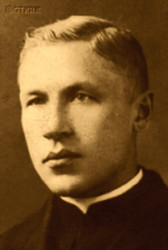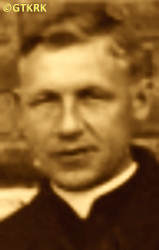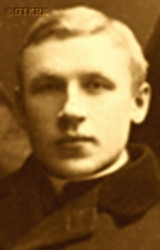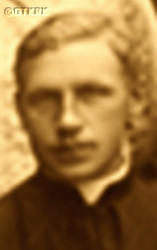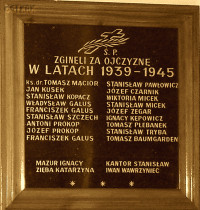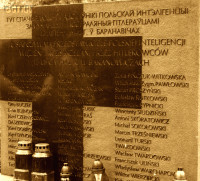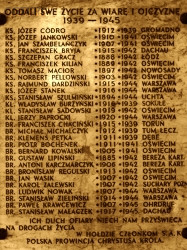Roman Catholic
St Sigismund parish
05-507 Słomczyn
85 Wiślana Str.
Konstancin deanery
Warsaw archdiocese, Poland
full list:
displayClick to display full list

searchClick to search full list by categories
wyświetlKliknij by wyświetlić pełną listę po polsku

szukajKliknij by przeszukać listę wg kategorii po polsku

Martyrology of the clergy — Poland
XX century (1914 – 1989)
personal data
surname
MĄCIOR
surname
versions/aliases
MĘCIOR
forename(s)
Thomas (pl. Tomasz)
function
religious cleric
creed
Latin (Roman Catholic) Church RCmore on
en.wikipedia.org
[access: 2014.09.21]
congregation
Society of the Catholic Apostolate SACmore on
en.wikipedia.org
[access: 2013.05.19]
(i.e. Pallottines)
diocese / province
Christ the King province SACmore on
waw.pallotyni.pl
[access: 2019.02.02]
academic distinctions
Doctor of Philosophy
Doctor of Theology
honorary titles
Gold „Cross of Merit”more on
en.wikipedia.org
[access: 2019.04.16]
(03.12.1938)
date and place
of death
13.07.1942

Polonkatoday: Polonka ssov., Baranavichy dist., Brest reg., Belarus
more on
be.wikipedia.org
[access: 2023.01.18]
details of death
After German and Russian invasion of Poland in 09.1939 and start of the World War II, after start of Russian occupation, Belarus Communist youth robbed and destroyed on 23.05.1940, on the feast of Corpus Christi, newly constructed parish common house in Nowosady.
In 10.1940 the church and his rectory were attacked — local Orthodox Belarusians took part.
Went into hiding. Initially slept in the forest and on the cemetery, later — during 1940‐1941 winter — found refuge at one his parishioners' houses.
After German attack on 22.06.1941 of their erstwhile ally, Russians, and start of German occupation, returned to his rectory.
Lived in single room — the remaining space was appropriated by the German troops. Helped and served as translator for Russians women held captive by the Germans.
Arrested on 29.06.1942 — by the Germans or collaborating with them Germ. Weißruthenische Hilfspolizei (Eng. Belarusian Auxiliary Police — after morning Holy Mass in Nowosady.
Taken to Baranavichy prison.
Next on c. 03.07.1942 transported to KL Koldichevo concentration camp.
From there driven out on a truck to the execution site and executed in a mass murder.
cause of death
mass murder
perpetrators
Germans / Belarusians
sites and events
Połonka (n. Baranavichy)Click to display the description, «Polenaktion» 1942Click to display the description, KL KoldichevoClick to display the description, Baranavichy (prison)Click to display the description, Ribbentrop‐MolotovClick to display the description, Pius XI's encyclicalsClick to display the description
date and place
of birth
16.12.1897

Szynwałdtoday: Skrzyszów gm., Tarnów pov., Lesser Poland voiv., Poland
more on
en.wikipedia.org
[access: 2021.09.02]
parents
MĄCIOR Adalbert
🞲 ?, ? — 🕆 ?, ?

JOP Salome
🞲 ?, ? — 🕆 ?, ?
religious vows
15.10.1919 (temporary)
22.10.1922 (permanent)
presbyter (holy orders)
ordination
19.04.1924

Rometoday: Rome prov., Lazio reg., Italy
more on
en.wikipedia.org
[access: 2021.12.18]
Most Holy Saviour, St John the Baptist and St John the Evangelist RC archbasilicamore on
en.wikipedia.org
[access: 2020.04.04] (in Lateran)
positions held
1936 – 1942
parish priest — Novosadytoday: Malakhovtsy ssov., Baranavichy dist., Brest reg., Belarus
more on
uk.wikipedia.org
[access: 2022.08.28] ⋄ Sacred Heart of Jesus RC parish ⋄ Baranavichytoday: Baranavichy dist., Brest reg., Belarus
more on
en.wikipedia.org
[access: 2022.05.02] RC deanery — acting („ad interim”)
1936 – 1942
rector — Novosadytoday: Malakhovtsy ssov., Baranavichy dist., Brest reg., Belarus
more on
uk.wikipedia.org
[access: 2022.08.28] ⋄ Society's house, Pallottines SAC
1938 – 1939
retreat — i.a. in Silesia and among Polish migrants in France
1935 – 1939
editor — „Queen of the Apostles” monthly
04.04.1935 – 1936
councillor — Polish Christ the King province, Pallottines SAC — first counselor of the newly constituted province
1934 – 1935
councillor — Polish Regia (region), Pallottines SAC
1934 – 1936
rector — Warsawtoday: Warsaw city pov., Masovia voiv., Poland
more on
en.wikipedia.org
[access: 2021.10.09] ⋄ Society's house (at 12 Skaryszewska Str.), Pallottines SAC
1934 – 1936
editor — „Apostle in the world” periodical
1932 – 1934
superior — Polish Regia (region), Pallottines SAC
1931 – 1932
General secretary — Pallottines SAC
from 1931
editor — „Analecta Piae Societatis Missionum” periodical
1929 – 1931
editor — „Catholic review” periodical
1927 – 1931
rector — Warsawtoday: Warsaw city pov., Masovia voiv., Poland
more on
en.wikipedia.org
[access: 2021.10.09] ⋄ Society's house (at 12 Skaryszewska Str.), Pallottines SAC
1926 – 1927
rector — Warsawtoday: Warsaw city pov., Masovia voiv., Poland
more on
en.wikipedia.org
[access: 2021.10.09] ⋄ St Joseph Society's house (at 17 Chełmska Str.), Pallottines SAC
till 1934
professor — Sucharytoday: Nakło nad Notecią gm., Nakło nad Notecią pov., Kuyavia‐Pomerania voiv., Poland
more on
en.wikipedia.org
[access: 2022.08.28] ⋄ Theological Seminary, Pallottines SAC — lecturer in dogmatic theology, canon law, ethics, history of philosophy and sociology
from 1928
professor — Ołtarzewtoday: Ożarów Mazowiecki gm., Warsaw‐west pov., Masovia voiv., Poland
more on
en.wikipedia.org
[access: 2022.07.18] ⋄ Theological Seminary, Pallottines SAC — lecturer in dogmatic theology, canon law, ethics, history of philosophy and sociology
c. 1926 – 1928
professor — Klecza Dolnatoday: Wadowice gm., Wadowice pov., Lesser Poland voiv., Poland
more on
en.wikipedia.org
[access: 2021.12.18] ⋄ „Collegium Marianum” Theological Seminary, „On the Mound” house, Pallottines SAC — lecturer in dogmatic theology, canon law, ethics, history of philosophy and sociology
1920 – 1924
PhD student — Rometoday: Rome prov., Lazio reg., Italy
more on
en.wikipedia.org
[access: 2021.12.18] ⋄ theology, „Gregorianum” [i.e. Lat. Pontificia Universitas Gregoriana (Eng. Pontifical Gregorian University)]
1920 – 1924
PhD student — Rometoday: Rome prov., Lazio reg., Italy
more on
en.wikipedia.org
[access: 2021.12.18] ⋄ philosophy, „Angelicum” [i.e. Lat. Pontificia Universitas Studiorum a Sancto Thoma Aquinate in Urbe (Eng. Pontifical University of St Thomas Aquinas) (today) / Lat. Pontificium Institutum Internationale (Eng. Pontifical International Institute) (1926‐1963) / Lat. Pontificium Collegium (Eng. Pontifical College) (1906‐1926) / Lat. Collegium (Eng. College) (until 1906)]
till 1920
student — Nakło nad Noteciątoday: Nakło nad Notecią gm., Nakło nad Notecią pov., Kuyavia‐Pomerania voiv., Poland
more on
en.wikipedia.org
[access: 2020.11.27] ⋄ philosophy and theology, Theological Seminary, Pallottines SAC
from 1918
student — Klecza Dolnatoday: Wadowice gm., Wadowice pov., Lesser Poland voiv., Poland
more on
en.wikipedia.org
[access: 2021.12.18] ⋄ theology and philosophy, „Collegium Marianum” Theological Seminary, „On the Mound” house, Pallottines SAC
1917 – 1919
novitiate — Klecza Dolnatoday: Wadowice gm., Wadowice pov., Lesser Poland voiv., Poland
more on
en.wikipedia.org
[access: 2021.12.18] ⋄ Society's house („On the Mound”), Pallottines SAC — robed on 28.10.1917
08.10.1917
accession — Pallottines SAC
author of i.a. „Here is the Heart that loved people so much”, Warsaw, 1933; „On the ruins of demolished altars”, Warsaw, 1934; dozens of articles in magazines and periodicals he edited
others related
in death
BARTUSZEKClick to display biography Joseph, BRYCZKOWSKIClick to display biography Boleslav, BUJNOWSKIClick to display biography Leo, GRZESIAKClick to display biography Thaddeus Michael, KARAMUCKIClick to display biography Louis, KLIMCZAKClick to display biography Vladislav, KUBIKClick to display biography Mieczyslav Anthony, KURAŚClick to display biography Vincent, OLESZCZUKClick to display biography Alphonse, PAWŁOWSKIClick to display biography Vladislav Sigismund, RUTKOWSKIClick to display biography Boleslav, SIUDZIŃSKIClick to display biography Vincent, ULIŃSKIClick to display biography Francis, WARCHAPOWICZClick to display biography Vladislav, WIERZBICKIClick to display biography Victor
sites and events
descriptions
Połonka (n. Baranavichy): Mass a group of approx. 50‐400 people (mainly Poles, including c. 15‐17 priests) carried out on 13.07.1942 2 by the Germ. Sonderkommando — a special unit of the Germ. Weißruthenische Hilfspolizei (Eng. Belarusian Auxiliary Police) collaborating with the Germans. The execution took place in a forest by Połonka village, c. 25 km to west from Baranavichy, and the wire‐bound prisoners where brought from KL Koldichevo concentration camp and Baranavichy prison. Prob. was part of German special action aimed at Polish intelligentsia and including mass herding and sending to Germany of Polish slave workers, known as «Polenaktion». (more on: www.stankiewicze.comClick to attempt to display webpage
[access: 2013.02.15], genealogia.plewako.plClick to attempt to display webpage
[access: 2014.09.21])
«Polenaktion» 1942: In the summer of 1942 in German‐occupied Germ. Generalbezirk Weißruthenien (Eng. General Region of Belarus) — in Nowogródek region among others — Germans carried out «Polenaktion» initiative: the name introduced in a special resolution drafted by Reichssicherheitshauptamt RSHA (Eng. Reich Main Security Office). The action included sacking of all Poles from civilian regional apparatus and police and replacing them with Belarusians. Thousands of Poles were also forcibly deported to Germany as slave labourers. On 26‐30.06.1942 in all counties of the region more than 1,000 representatives of Polish intelligentsia were arrested and subsequently murdered. In Lida region 16 Polish priests were arrested among others. 5 Polish parish priests from Hlybokaye and Pastavy deanery were murdered as well. At the same time Germans set up KL Koldichevo concentration camp n. Baranavichy. The implementation of this genocide project was entrusted to Belarusian collaborationist formations, political, administrative — responsible for preparation of proscription lists — and police, i.e. niem. Weißruthenische Hilfspolizei (Eng. Belarusian Auxiliary Police), supported by Ukrainian, Lithuanian, Latvian and Russian (RONA) collaborators. The action was coordinated with the liquidation of the Jewish ghettos in the Germ. Generalbezirk Weißruthenien.
KL Koldichevo: German Germ. Konzentrationslager (Eng. concentration camp) KL and death/extermination camp operational from 03.1942 to 07.1944 in Koldychevo village, 20 km from Baranavichy, in Belarus — to be precise in Germ. Generalbezirk Weißruthenien (Eng. General Districtorate of Belarus), part of the occupation entity called the Germ. Reichskommissariat Ostland (Eng. Reichskommissariat East). Jews and Poles, among others, were held in the camp, which was supervised by several Germans, but the managers, guards and executioners were Belarusians, and the language of orders and commands was Belarusian — the crew were members of the 4th Company of the 13th Belarusian Police Battalion SD (Germ. Weissruthenische Schutzmannschafts Bataillon der SD 13), which was part of the collaborationist Germ. Weißruthenische Hilfspolizei (Eng. Belarusian Auxiliary Police). A crematorium was opened in the camp. It witnessed c. 22,000 victims being murdered and exterminated — men, women, children, old, of various professions and social status, mainly Polish nationals, including c. 24 Catholic priests. Some of them were murdered by deadly gas, prob. in specially equipped trucks (the bodies were subsequently dumped in Lakhivka forest, c. 2 km from the camp). Others were taken to Polonka and murdered there. Victims were also murdered by the Belarusians with a shot to the back of the head or with sticks with protruding nails. (more on: en.wikipedia.orgClick to attempt to display webpage
[access: 2023.08.31], www.sztetl.org.plClick to attempt to display webpage
[access: 2013.12.04])
Baranavichy (prison): Prison in 1939‐1941 run by Russians and in 1941‐1944 by Germans. (more on: pl.wikipedia.orgClick to attempt to display webpage
[access: 2013.08.17])
Ribbentrop‐Molotov: Genocidal Russian‐German alliance pact between Russian leader Joseph Stalin and German leader Adolf Hitler signed on 23.08.1939 in Moscow by respective foreign ministers, Mr. Vyacheslav Molotov for Russia and Joachim von Ribbentrop for Germany. The pact sanctioned and was the direct cause of joint Russian and German invasion of Poland and the outbreak of the World War II in 09.1939. In a political sense, the pact was an attempt to restore the status quo ante before 1914, with one exception, namely the „commercial” exchange of the so‐called „Kingdom of Poland”, which in 1914 was part of the Russian Empire, fore Eastern Galicia (today's western Ukraine), in 1914 belonging to the Austro‐Hungarian Empire. Galicia, including Lviv, was to be taken over by the Russians, the „Kingdom of Poland” — under the name of the General Governorate — Germany. The resultant „war was one of the greatest calamities and dramas of humanity in history, for two atheistic and anti‐Christian ideologies — national and international socialism — rejected God and His fifth Decalogue commandment: Thou shall not kill!” (Abp Stanislav Gądecki, 01.09.2019). The decisions taken — backed up by the betrayal of the formal allies of Poland, France and Germany, which on 12.09.1939, at a joint conference in Abbeville, decided not to provide aid to attacked Poland and not to take military action against Germany (a clear breach of treaty obligations with Poland) — were on 28.09.1939 slightly altered and made more precise when a treaty on „German‐Russian boundaries and friendship” was agreed by the same murderous signatories. One of its findings was establishment of spheres of influence in Central and Eastern Europe and in consequence IV partition of Poland. In one of its secret annexes agreed, that: „the Signatories will not tolerate on its respective territories any Polish propaganda that affects the territory of the other Side. On their respective territories they will suppress all such propaganda and inform each other of the measures taken to accomplish it”. The agreements resulted in a series of meeting between two genocidal organization representing both sides — German Gestapo and Russian NKVD when coordination of efforts to exterminate Polish intelligentsia and Polish leading classes (in Germany called «Intelligenzaktion», in Russia took the form of Katyń massacres) where discussed. Resulted in deaths of hundreds of thousands of Polish intelligentsia, including thousands of priests presented here, and tens of millions of ordinary people,. The results of this Russian‐German pact lasted till 1989 and are still in evidence even today. (more on: en.wikipedia.orgClick to attempt to display webpage
[access: 2015.09.30])
Pius XI's encyclicals: Facing the creation of two totalitarian systems in Europe, which seemed to compete with each other, though there were more similarities than contradictions between them, Pope Pius XI issued in 03.1937 (within 5 days) two encyclicals. In the „Mit brennender Sorge” (Eng. „With Burning Concern”) published on 14.03.1938, condemned the national socialism prevailing in Germany. The Pope wrote: „Whoever, following the old Germanic‐pre‐Christian beliefs, puts various impersonal fate in the place of a personal God, denies the wisdom of God and Providence […], whoever exalts earthly values: race or nation, or state, or state system, representatives of state power or other fundamental values of human society, […] and makes them the highest standard of all values, including religious ones, and idolizes them, this one […] is far from true faith in God and from a worldview corresponding to such faith”. On 19.03.1937, published „Divini Redemptoris” (Eng. „Divine Redeemer”), in which criticized Russian communism, dialectical materialism and the class struggle theory. The Pope wrote: „Communism deprives man of freedom, and therefore the spiritual basis of all life norms. It deprives the human person of all his dignity and any moral support with which he could resist the onslaught of blind passions […] This is the new gospel that Bolshevik and godless communism preaches as a message of salvation and redemption of humanity”… Pius XI demanded that the established human law be subjected to the natural law of God , recommended the implementation of the ideal of a Christian state and society, and called on Catholics to resist. Two years later, National Socialist Germany and Communist Russia came together and started World War II. (more on: www.vatican.vaClick to attempt to display webpage
[access: 2023.05.28], www.vatican.vaClick to attempt to display webpage
[access: 2023.05.28])
sources
personal:
wsdsac.plClick to attempt to display webpage
[access: 2012.12.28], libermortuorum.plClick to attempt to display webpage
[access: 2019.05.30]
original images:
szynwald.plClick to attempt to display webpage
[access: 2022.08.28], libermortuorum.plClick to attempt to display webpage
[access: 2018.09.02], libermortuorum.plClick to attempt to display webpage
[access: 2018.09.02], tuszynwald.plClick to attempt to display webpage
[access: 2013.12.04], www.svaboda.orgClick to attempt to display webpage
[access: 2015.09.30], turystyka.ozarow-mazowiecki.plClick to attempt to display webpage
[access: 2017.11.07]
LETTER to CUSTODIAN/ADMINISTRATOR
If you have an Email client on your communicator/computer — such as Mozilla Thunderbird, Windows Mail or Microsoft Outlook, described at WikipediaPatrz:
en.wikipedia.org, among others — try the link below, please:
LETTER to CUSTODIAN/ADMINISTRATORClick and try to call your own Email client
If however you do not run such a client or the above link is not active please send an email to the Custodian/Administrator using your account — in your customary email/correspondence engine — at the following address:

giving the following as the subject:
MARTYROLOGY: MĄCIOR Thomas
To return to the biography press below:
 Click to return to biography
Click to return to biography








